Yellow-rumped warbler
| Yellow-rumped warbler | |
|---|---|
 | |
| Adult male "Audubon's" yellow-rumped warbler in alternate plumage, S. coronata, auduboni group | |
| Scientific classification | |
| Kingdom: | Animalia |
| Phylum: | Chordata |
| Class: | Aves |
| Order: | Passeriformes |
| Family: | Parulidae |
| Genus: | Setophaga |
| Species: | S. coronata |
| Binomial name | |
| Setophaga coronata (Linnaeus, 1766) | |
| Subspecies | |
| |
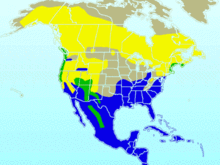 | |
| Summer only range Winter only range Year-round rangeGoldman's warbler range not included in map | |
| Synonyms | |
|
Dendroica coronata | |
The yellow-rumped warbler (Setophaga coronata) is a North American bird species combining four closely related forms: the eastern myrtle warbler (ssp coronata); its western counterpart, Audubon's warbler (ssp group auduboni); the northwest Mexican black-fronted warbler (ssp nigrifrons); and the Guatemalan Goldman's warbler (ssp goldmani).
Etymology
The genus name Setophaga is from Ancient Greek ses, "moth", and phagos, "eating", and the specific coronata means "crowned".[2]
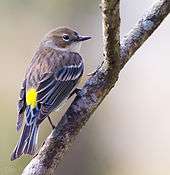
Classification
Since 1973, the American Ornithologists' Union has elected to merge these passerine birds as one species. There is a pending proposal to recognize the yellow-rumped warbler as four [species] rather than as the present[sub-species].[3][4][5]
The myrtle form was apparently separated from the others by glaciation during the Pleistocene, and the Audubon's form may have originated more recently through hybridization between the myrtle warbler and the Mexican nigrifrons form.[5][6]
Distribution
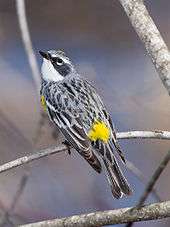
The yellow-rumped warbler breeds from eastern North America west to the Pacific, and southward from there into Western Mexico. "Goldman's" yellow-rumped warbler is a non-migratory endemic within the highlands of Guatemala and the black-fronted warbler is also a non-migratory Mexican endemic.[5] The myrtle and Audubon's forms are migratory, traveling to the southern U.S., Mexico, Central America, and the Caribbean for winters. Among warblers Audubon's is by far the most widespread in North America in winter, and in the northern and central parts of the continent, it is among the last to leave in the fall and among the first to return and is an occasional vagrant to the British Isles and Iceland.
Habitat
Yellow-rumped warblers spend the breeding season in mature coniferous and mixed coniferous-deciduous woodlands (such as in patches of aspen, birch, or willow). In the western U.S. and in the central Appalachian Mountains, they are found mostly in mountainous areas. In the Pacific Northwest and the Northeastern U.S., they occur all the way down to sea level wherever conifers are present. During winter, yellow-rumped warblers find open areas with fruiting shrubs or scattered trees, such as parks, streamside woodlands, open pine and pine-oak forest, dunes (where bayberries are common), and residential areas. On their tropical wintering grounds they live in mangroves, thorn scrub, pine-oak-fir forests, and shade coffee plantations.[7]
Description
This is a mid-sized New World warbler, though it is one of the largest species in the Setophaga genus (formerly Dendroica) which comprises a lion's share of the species in the family. In total length, the species can range from 12 to 15 cm (4.7 to 5.9 in) long, with a wingspan of 19 to 24 cm (7.5 to 9.4 in). Body mass can vary from 9.9 to 17.7 g (0.35 to 0.62 oz), though averages between 11 and 14 g (0.39 and 0.49 oz). Among standard measurements, the wing chord is 6.3 to 8.4 cm (2.5 to 3.3 in), the tail is 5 to 6.6 cm (2.0 to 2.6 in), the bill is 0.8 to 1.1 cm (0.31 to 0.43 in) and the tarsus is 1.8 to 2.2 cm (0.71 to 0.87 in).[8] In summers, males of both forms have streaked backs of black on slate blue, white wing patches, a streaked breast, and conspicuous yellow patches on the crown, flank, and rump (the latter giving rise to the species's nickname "butterbutt" among birdwatchers[9]). Audubon's warbler also sports a yellow throat patch, while the myrtle warbler has a white throat and eye stripe, and a contrasting black cheek patch. Females of both forms are more dull, with brown streaking front and back, but still have noticeable yellow rumps. Goldman's warbler, of Guatemala, resembles Audubon's but has a white lower border to the yellow throat and otherwise darker plumage; males replace the slate blue of Audubon's with black.
Behavior
Audubon's and the myrtle are among North America's most abundant neotropical migrants. They are primarily insectivorous. The species is perhaps the most versatile foragers of all warblers. Beyond gleaning from leaves like other New World warblers, they often flit, flycatcher-like, out from their perches in short loops, to catch flying insects. Other places yellow-rumped warblers have been spotted foraging include picking at insects on washed-up seaweed at the beach, skimming insects from the surface of rivers and the ocean, picking them out of spiderwebs, and grabbing them off piles of manure. Common foods include caterpillars and other larvae, leaf beetles, bark beetles, weevils, ants, scale insects, aphids, grasshoppers, caddisflies, craneflies, and gnats, as well as spiders. They also eat spruce budworm, a serious forest pest, during outbreaks.[7]
When bugs are scarce, the myrtle warbler also eats fruit, including the wax-myrtle berries which gave it its name. It is the only warbler able to digest such waxy material. The ability to use these fruits allows it to winter farther north than other warblers, sometimes as far north as Newfoundland. Other commonly eaten fruits include juniper berries, poison ivy, poison oak, greenbrier, grapes, Virginia creeper and dogwood. They eat wild seeds such as from beach grasses and goldenrod, and they may come to feeders, where they'll take sunflower seeds, raisins, peanut butter, and suet. On their wintering grounds in Mexico they've been seen sipping the sweet honeydew liquid excreted by aphids. Male yellow-rumped warblers tend to forage higher in the trees than females do. While foraging with other warbler species, they sometimes aggressively displace other species, including pine warblers and Blackburnian warblers.[7]
Audubon's and the myrtle nest in coniferous and mixed woodlands, and lay 4–5 eggs. Females build the nest, sometimes using material the male carries to her. The nest is a cup of twigs, pine needles, grasses, and rootlets. She may also use moose, horse, and deer hair, moss, and lichens. She lines this cup with fine hair and feathers, sometimes woven into the nest in such a way that they curl up and over the eggs. The nest takes about 10 days to build. Nests are located on the horizontal branch of a conifer, anywhere from 1.2 to 15 m (3.9 to 49.2 ft) high. Tree species include hemlock, spruce, white cedar, pine, Douglas-fir, and larch or tamarack. They may build their nests far out on a main branch or tuck it close to the trunk in a secure fork of two or more branches. Occasionally nest are built in a deciduous tree such as a maple, oak or birch. The eggs are incubated for 12 to 13 days. Nestlings are helpless and naked at hatching but grow quickly. The young are brooded for 10 to 14 days, at which point they can fledge.[7]
The yellow-rumped warbler has a trill-like song of 4–7 syllables (tyew-tyew-tyew-tyew,tew-tew-tew) and an occasional check or chip call note.
Gallery
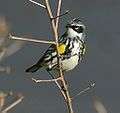
- Yellow-rumped warbler in fall/winter plumage, November 29, 2014.
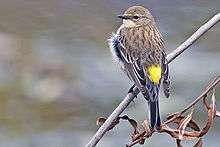
References
- ↑ BirdLife International (2012). "Dendroica coronata". IUCN Red List of Threatened Species. Version 2013.2. International Union for Conservation of Nature. Retrieved 26 November 2013.
- ↑ Jobling, James A. (2010). The Helm Dictionary of Scientific Bird Names. London, United Kingdom: Christopher Helm. pp. 118, 355,. ISBN 978-1-4081-2501-4.
- ↑ Powell, Hugh. "Goodbye, Yellow-rump: Will We See a Return to Myrtle and Audubon's Warblers?". Cornell University. Retrieved 13 September 2016.
- ↑ Toews, D.; Brelsford, A.; Grossen, C.; Milá, B.; Irwin, D.E. (2016). "Genomic variation across the Yellow-rumped Warbler species complex". Auk. 133 (4): 698–717. Retrieved 13 September 2016.
- 1 2 3 Toews, David P.; Mandic, Milica; Richards, Jeffrey G.; Irwin, Darren E. (2013). "Migration, mitochondria and the Yellow-rumped Warbler.". Evolution (68-1): 241–255. doi:10.1111/evo.12260.
- ↑ Brelsford, Alan; Milá, Borja; Irwin, Darren E. "Hybrid origin of Audubon's warbler". Molecular Ecology. doi:10.1111/j.1365-294X.2011.05055.x.
- 1 2 3 4
- ↑ New World Warblers (Helm Field Guides) by Jon Curson. Christopher Helm Publishers (1993). 978-0713639322.
- ↑ Taft, Dave (October 31, 2014). "Meet the Butter Butt, One Tough Bird". The New York Times. Retrieved July 9, 2016.
External links
| Wikimedia Commons has media related to Yellow-rumped warbler. |
| Wikispecies has information related to: Setophaga coronata |
- Yellow-rumped warbler species account – Cornell Lab of Ornithology
- Yellow-rumped warbler - Dendroica coronata – USGS Patuxent Bird Identification InfoCenter
- "Yellow-rumped warbler media". Internet Bird Collection.
- Yellow-rumped warbler photo gallery at VIREO (Drexel University)
